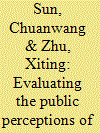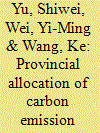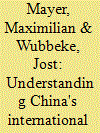|
|
|
Sort Order |
|
|
|
Items / Page
|
|
|
|
|
|
|
| Srl | Item |
| 1 |
ID:
132634


|
|
|
|
|
| Publication |
2014.
|
| Summary/Abstract |
To alleviate the problem of the insufficient reserves of natural gas in China, coal-based synthetic natural gas (SNG) is considered to be a promising option as a source of clean energy, especially for urban use. However, recent study showed that SNG will not accomplish the task of simultaneous energy conservation and CO2 reduction. In this paper, life cycle costing is made for SNG use in three main applications in residential sector: heating, household use, and public transport. Comparisons are conducted between SNG and coal, natural gas, liquefied petroleum gas (LPG), diesel, and methanol. The results show that SNG is a competitive option only for household use. The use of SNG for heating boilers or city buses is not as cost-effective as expected. The biggest shortcoming of SNG is the large amount of pollutants generated in the production stage. At the moment, the use of SNG is promoted by the government. However, as shown in this paper, one can expect a transfer of pollution from the urban areas to the regions where SNG is produced. Therefore, it is suggested that well-balanced set of environmental damage-compensating policies should be introduced to compensate the environmental losses in the SNG-producing regions.
|
|
|
|
|
|
|
|
|
|
|
|
|
|
|
|
| 2 |
ID:
132682


|
|
|
|
|
| Publication |
2014.
|
| Summary/Abstract |
Coal-fired power plants in China have emitted multiple pollutants including sulfur dioxide, nitrogen oxides and fine particulates, contributing to serious environmental impairments and human health issues. To meet ambient air quality standards, the installation of effective pollution control technologies are required and consequently, the cost of installing or retrofitting control technologies is an important economic and political concern. A multi-pollutant control cost model, CoST CE, is developed to calculate the cost of multi-pollutant control strategies in the Yangtze River Delta region (YRD) of China, adopting an LP algorithm to optimize the sorting of control technology costs and quickly obtain a solution. The output shows that total costs will increase along with emission abatement. Meanwhile, the slope becomes steeper as greater emission reductions are pursued, due to the need to install highly effective, but expensive, technologies like SCR and FF. Moreover, it is evident that the cost curve shapes, maximum abatement potential and total cost for the three provinces in the YRD region are quite different due to differences in power plant type and technologies, current emission levels and existing pollution controls. The results from this study can aid policy makers to develop cost-effective control strategies for the power sector.
|
|
|
|
|
|
|
|
|
|
|
|
|
|
|
|
| 3 |
ID:
112430


|
|
|
| 4 |
ID:
127910


|
|
|
|
|
| Publication |
2014.
|
| Summary/Abstract |
To cope with the excessive growth of energy consumption, the Chinese government has been trying to strengthen the energy regulation system by introducing new initiatives that aim at controlling the total amount of energy consumption. A partial frontier analysis is performed in this paper to make a comparative assessment of the combinations of possible energy conservation objectives, new constraints and regulation strategies. According to the characteristics of the coordination of existing regulation structure and the optimality of regulation strategy, four scenarios are constructed and regional responsibilities are reasonably divided by fully considering the production technology in the economy. The relative importance of output objectives and the total amount controlling is compared and the impacts on the regional economy caused by the changes of regulation strategy are also evaluated for updating regulation policy.
|
|
|
|
|
|
|
|
|
|
|
|
|
|
|
|
| 5 |
ID:
132674


|
|
|
|
|
| Publication |
2014.
|
| Summary/Abstract |
After the Fukushima nuclear accident, more and more attention has been paid to the safety issues of nuclear power in China, even though it is a clean and necessary substitution to coal power. Due to the consideration about the uncertainty of nuclear safety, the local citizens may resist the nuclear power programs in their neighborhood, as indicated by the anti-nuclear movement in Jiangmen 2013. This phenomenon is often related to the public perceptions of "not-in-my-back-yard" (NIMABY). The explosion of anti-nuclear movements will impose adverse effects on the nuclear power decision-making in China. Based on the Contingent Valuation Method (CVM), we evaluate the public Willingness-To-Pay (WTP) for avoiding the construction of nuclear power plants in their neighborhood. Moreover, we analyze whether more information about nuclear energy could improve the public acceptance. Our results show that the comprehensive information will decrease the public risk perception of nuclear power and increase the public support for nuclear power policy. This paper further suggests that China×s decision makers should improve policy transparency and encourage the public involvement of nuclear energy decision making.
|
|
|
|
|
|
|
|
|
|
|
|
|
|
|
|
| 6 |
ID:
128047


|
|
|
|
|
| Publication |
2014.
|
| Summary/Abstract |
An approach to determine carbon emission reduction target allocation based on the particle swarm optimization (PSO) algorithm, fuzzy c-means (FCM) clustering algorithm, and Shapley decomposition (PSO-FCM-Shapley) is proposed in this study. The method decomposes total carbon emissions into an interaction result of four components (i.e., emissions from primary, secondary, and tertiary industries, and from residential areas) which composed totally by 13 macro influential factors according to the KAYA identity. Then, 30 provinces in China are clustered into four classes according to the influential factors via the PSO-FCM clustering method. The key factors that determine emission growth in the provinces representing each cluster are investigated by applying Shapley value decomposition. Finally, based on guaranteed survival emissions, the reduction burden is allocated by controlling the key factors that decelerate CO2 emission growth rate according to the present economic development level, energy endowments, living standards, and the emission intensity of each province. A case study of the allocation of CO2 intensity reduction targets in China by 2020 is then conducted via the proposed method. The per capita added value of the secondary industry is the primary factor for the increasing carbon emissions in provinces. Therefore, China should limit the growth rate of its secondary industry to mitigate emission growth. Provinces with high cardinality of emissions have to shoulder the largest reduction, whereas provinces with low emission intensity met the minimum requirements for emission in 2010. Fifteen provinces are expected to exceed the national average decrease rates from 2011 to 2020.
|
|
|
|
|
|
|
|
|
|
|
|
|
|
|
|
| 7 |
ID:
123758


|
|
|
|
|
| Publication |
2013.
|
| Summary/Abstract |
Focusing on the relationship between oil imports and China's compromising and business-like attitude, this article shows that empirical observations do not support several commonplace assumptions that China's growing oil dependence leads to conflict scenarios. The non-escalating nature of the Chinese energy policy constitutes an intriguing puzzle. Although the country currently relies on foreign oil for more than half of its consumption, it does not possess a single overseas base, has not employed troops to secure oil supplies, and strongly relies on world markets to satisfy the growing energy demand. Instead, the main components of the Chinese policy are based on pragmatism fostering integration into existing supply systems and market institutions. This analysis, in turn, points to the importance of structural conditions within global energy politics on the one hand, and pragmatist behaviour on the other, rather than internal motivations or strategic intentions, in order to understand the evolution of China's energy policies. Finally, we briefly discuss the possibility of a reverse dynamic-possibly emerging due to a changing regional or global environment.
|
|
|
|
|
|
|
|
|
|
|
|
|
|
|
|
| 8 |
ID:
132615


|
|
|
|
|
| Publication |
2014.
|
| Summary/Abstract |
The energy rebound effect has been a significant issue in China, which is undergoing economic transition, since it reflects the effectiveness of energy-saving policy relying on improved energy efficiency. Based on the IPAT equation and Brookes× explanation of the rebound effect, this paper develops an alternative estimation model of the rebound effect. By using the estimation model and latent variable approach, which is achieved through a time-varying coefficient state space model, we estimate China×s economy-wide energy rebound effect over 1954-2010. The results show that the rebound effect evidently exists in China as a result of the annual average of 39.73% over 1954-2010. Before and after the implementation of China×s reform and opening-up policy in 1978, the rebound effects are 47.24% and 37.32%, with a strong fluctuation and a circuitously downward trend, respectively, indicating that a stable political environment and the development of market economy system facilitate the effectiveness of energy-saving policy. Although the energy-saving effect of improving energy efficiency has been partly realised, there remains a large energy-saving potential in China.
|
|
|
|
|
|
|
|
|
|
|
|
|
|
|
|
| 9 |
ID:
132640


|
|
|
|
|
| Publication |
2014.
|
| Summary/Abstract |
There has been much attention paid to oil security in China in recent years. Although China has begun to establish its own strategic petroleum reserve (SPR) to prevent potential losses caused by oil supply interruptions, the system aiming to ensure China×s oil security is still incomplete. This paper describes and provides evidence for the benefits of an auxiliary strategic oil policy choice, which aims to strengthen China×s oil supply security and offer a solution for strategic oil operations with different holding costs. In this paper, we develop a multi-dimension stochastic dynamic programming model to analyze the oil stockpile delegation policy, which is an intermediate policy between public and private oil stockpiles and is appropriate for the Chinese immature private oil stockpile sector. The model examines the effects of the oil stockpile delegation policy in the context of several distinct situations, including normal world oil market conditions, slight oil supply interruption, and serious oil supply interruption. Operating strategies that respond to different oil supply situations for both the SPR and the delegated oil stockpile were obtained. Different time horizons, interruption times and holding costs of delegated oil stockpiles were examined. The construction process of China×s SPR was also taken into account.
|
|
|
|
|
|
|
|
|
|
|
|
|
|
|
|
|
|
|
|
|